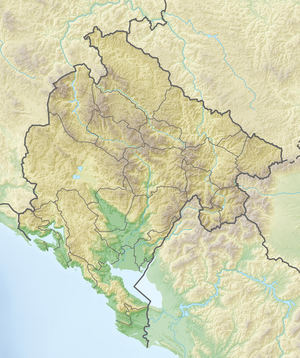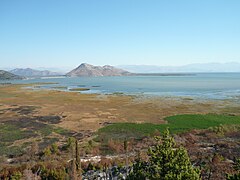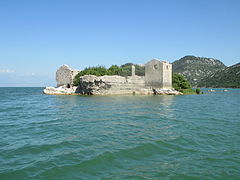Skadar Lake
| Skadar Lake | ||
|---|---|---|

|
||
| Albanian east bank north of Shkodra | ||
| Geographical location |
|
|
| Tributaries | Morača u. a. | |
| Drain | Buna / Boyana | |
| Data | ||
| Coordinates | 42 ° 10 ′ N , 19 ° 19 ′ E | |
|
|
||
| Altitude above sea level | 7 m | |
| surface | 370-530 km² | |
| length | 48 km | |
| width | 14 km | |
| Maximum depth | 44 m | |
| Middle deep | 7 m | |
|
particularities |
largest lake on the Balkan Peninsula |
|
The Skadar Lake (also Shkodrasee or Skadar ; Albanian Liqen / -ii Shkodrës , Serbian and Montenegrin Скадарско језеро Skadarsko Jezero ) is the largest lake in the Balkans and - depending on the view - next to Lake Garda , the largest lake in southern Europe . The name of the lake used here comes from the Italian name used earlier for the Albanian city of Shkodra (Serbian / Montenegrin Скадар / Skadar ) at the southeastern tip of the lake . The lake is located in the border area between Montenegro and Albania, the Montenegrin part of the area of the lake is slightly larger than the Albanian. To the south-west it is separated from the Adriatic Sea , which is only 20 kilometers away, by the Rumija mountains, which are up to 1,600 meters high , while on the north-east side there is a wide, partly swampy plain.
geography
The Skadar Lake is 48 kilometers long and up to 14 kilometers wide. It lies in a tectonically formed polje and is 368 km² in size (219 km² of which in Montenegro and 149 km² in Albania). The water level of the lake fluctuates strongly, depending on the season by up to five meters. This also leads to a strong fluctuation of the surface between 370 km² and 540 km² during floods after the snowmelt. The average height above sea level is seven meters. The water depth is often only five to nine meters. Some underground springs , also called eyes , from which the lake is fed, among other things, are up to 44 meters deep. As a cryptodepression , the lake bed is partially below sea level.
The main tributary is the Morača on the Montenegrin side, it feeds the lake to 60 percent. The outflow to the Adriatic is the Buna (Alb .; Serbian Bojana ), which marks the border between Albania and Montenegro for almost its entire length .
Along the southwestern Montenegrin shore there are some small islands such as Beška , Moračnik , Starčevo or Grmožur , on which there are various small churches and castle ruins. Approximately in the middle of the northeast bank is a narrow arm that extends about 15 kilometers into the country, called the Bay of Hoti ( Albanian Gjiri i Hotit ) in Albania .
The east and north banks are mostly flat and difficult to access. On the steeper south-west bank there are various places: Virpazar in the north, south of it Godinje , Bobovište and Ckla , on the other side of the border Zogaj and Shiroka .
Geological evolution
Unlike the tectonically laid out and geologically old Lake Ohrid, Lake Skadar is geologically very young. Its current form has more or less only set within the last 18,000 years. During the Ice Age , all of the surrounding mountains were partly heavily glaciated. Therefore, even during the Ice Ages, the lake was heavily dependent on the glacial runoff regime of the river systems of that time. Even today, the tributaries of the Dinaric high mountains feed the Skadar Lake . The water supply due to the karstification of the landscape is very complex. Even underground springs are part of the feed system, as some rivers such as the Cijevna partially disappear underground (see Ponor ).
climate
The climate is sub- Mediterranean . In addition to mild and rainy winters, in which the temperature hardly drops below 5 ° C, there are hot and dry summers with maximum daily temperatures of over 40 ° C. The water temperature fluctuates between 7.3 ° C in winter and 27.2 ° C in summer.
Flora and fauna
The lake basin is a sensitive ecosystem that is home to over 20 endemic animal and plant species.
The Scutarian water frog , which is found all over the nearby region, was named after the lake. The water frogs are classified as important for the food chain in the lake.
The Skadar Lake is important as a resting and breeding place for migratory birds from Northern Europe. They overwinter by the lake or use it as a resting place on their train in spring. The Dalmatian Pelican has been nesting on Lake Skadar again since 2014.
The Montenegrin part of Lake Skadar was declared a national park in 1983 and was included in the international Ramsar list of protected wetlands in 1996 . In 2005 the Albanian part was also placed under protection as a nature reserve.
photos
Western end of the lake at Rijeka Crnojevića
Dam at Virpazar and the Morača estuary
See also
literature
- V. Stevanović, V. Vasić (eds.): Biodiverzitet Jugoslavije sa pregledom vrsta od međunarodnog značaja. Biološki facultet, Belgrade
Web links
- The region around Lake Skadar on a scale of 1: 200,000 - map from 1904
Individual evidence
- ^ Niko Pano: Fjalor enciklopedik shqiptar . Ed .: Akademia e Shkencave e RPSSH. Tirana 1985, keyword Liqeni i Shkodrës , p. 626 .
- ^ The splendid Skadar Lake (Montenegro and Albania), surprises with new species of snails. In: Science Codex. March 29, 2013, accessed on March 30, 2013 (English): "These circumstances and the reported decline in endemic gastropod diversity should trigger efforts to save this sensitive lake ecosystem. The IUCN Red List of Threatened Species includes 21 endemic species from the Skadar Lake basin "
- ^ Lake Shk or Transboundary Diagnostics Analysis. (PDF; 7.4 MB) Final Report: Main Document. World Bank, April 20, 2006, accessed July 21, 2013 .
- ↑ How Floating Nests May Save One of the World's Largest Water Birds. In: Smithsonian Magazine. December 7, 2015, accessed on December 13, 2015 (English): "Thanks to the continued conservation efforts of this project, in 2014 Skadar Lake Colony had its first successful breeding season in decades, only to be surpassed by this year's results. Last year, 70 pelicans gave birth to 48 surviving chicks, the biggest number of surviving young in the 37 years since annual counts began. "





